Opal, a precious stone with a unique crystal structure, is known for its brilliant colours and spectral patterns. It is a form of silica and a mineraloid, lacking a defined crystal lattice. Opals are found in notable deposits worldwide, particularly in the Australian opal fields, where iconic specimens like the Olympic Australis and White Cliffs opals are found.The body colour of opals varies, from pink to black, and unique types like contra-luz and holy water opals add to its allure. The Virgin Valley in Nevada is another prominent source of vibrant opals. Opals, including fire opals, are popular in jewellery and collection markets, with platforms like Opal Auctions showcasing their strong and diverse colours.
Opal is a hydrated amorphous form of silica with water content ranging from 3% to 21% by weight. The gem belongs to the mineraloid family, displaying a distinctive play of color caused by microscopic silica spheres that refract and diffract light. These silica spheres, arranged in tightly packed patterns, create the stone’s signature rainbow-like appearance, with larger spheres producing red and orange hues while smaller ones generate blue and violet colours. The stone forms when silica-rich water deposits gel-like substances in rock crevices and gaps, often near hot springs and geysers. Its composition includes hydrated silicon dioxide (SiO2·nH2O), with most gem-quality specimens containing 6% to 10% water content. The gem exhibits a vitreous to resinous lustre. Australia produces over 90% of the world’s opals, though significant deposits exist in Ethiopia, discovered in 1994 and 2008. The stone appears in various forms, including precious opal, which displays vibrant color play, and common opal (potch), which lacks this optical phenomenon due to its random atomic arrangement.
Opal is a gem classified as a mineraloid, not a crystal, due to its amorphous structure lacking a defined crystalline lattice. Composed of hydrated silica, its unique internal arrangement of microscopic silica spheres diffracts lightThe classification as a mineraloid stems from its formation process, where silica-rich solutions solidify without crystallization at relatively low temperatures. This non-crystalline nature influences its physical properties, including a lower hardness (5.5-6.5 on Mohs scale) compared to crystalline gems.While opal qualifies as a gemstone based on its use in jewellery and ornamental applications, its amorphous structure separates it from true crystal gemstones like diamonds, rubies, or sapphires.
The gem manifests in base colours of white, black, blue, or crystal-clear, with internal flashes of red, blue, green, and violet dancing across its surface. The stone’s structure consists of orderly arranged spheres of silica, measuring 150 to 300 nanometers in diameter, which create a three-dimensional grid that splits white light into its spectral components. These spheres generate different color displays based on their size: larger spheres produce reds and oranges, while smaller ones create blues and violets.Found in diverse opal deposits worldwide, including Australia and the Czech Republic, opals vary in body colour from white and black to rare pink opals.Its distinctive patterns include pinfire (small, closely spaced color patches), Harlequin (angular blocks of color), and flame patterns (streaking flashes of color). Boulder opals present as thin seams of precious opal within ironstone matrix, while black opals display bright color play against a dark body tone.The opal surface showcases vibrant hues, with some varieties, such as contra-luz opals, revealing strong colours when light passes through them.
The stone’s structure consists of orderly arranged spheres of silica, measuring 150 to 300 nanometers in diameter, which create a three-dimensional grid that splits white light into its spectral components. These spheres generate different color displays based on their size: larger spheres produce reds and oranges, while smaller ones create blues and violets.Found in diverse opal deposits worldwide, including Australia and the Czech Republic, opals vary in body colour from white and black to rare pink opals.Its distinctive patterns include pinfire (small, closely spaced color patches), Harlequin (angular blocks of color), and flame patterns (streaking flashes of color). Boulder opals present as thin seams of precious opal within ironstone matrix, while black opals display bright color play against a dark body tone.The opal surface showcases vibrant hues, with some varieties, such as contra-luz opals, revealing strong colours when light passes through them.
Opal’s colour patterns are rare due to the precise arrangement of microscopic silica spheres within its structure, which must be uniform in size and closely packed in a three-dimensional grid for light to diffract and create the play-of-colour effect known as opalescence.Variations in these spheres determine the wavelength of diffracted light, producing a spectrum of vibrant colours. The rarity is heightened by natural conditions like silica-rich water, specific temperatures, and geological stability over millions of years.
The internal structure contains tightly packed silicon balls with moisture trapped between them, creating a natural light-bending mechanism that produces brilliant flashes of color.The gem stands apart through its formation process, which occurs when silica-rich water seeps into rock crevices over millions of years, creating distinctive patterns and color combinations that make each stone unique. The size of silicon spheres determines specific color outputs – 0.2 microns produce blue, 0.25 microns create green, and 0.32 microns generate red.Rare patterns like Harlequin or pinfire add to its allure, while unique types like contra-luz opals display colours only when viewed against light. Its formation in specific deposits requires precise geological conditions, adding to its scarcity and value.Known as a symbol of creativity, mystery, and beauty, opal’s combination of scientific rarity and artistic appeal makes it a fascinating and enigmatic gemstone.
Opal is a gemstone with a rich cultural history, often associated with creativity, hope, and purity. Ancient Romans believed it to bring good fortune, while Arabic folklore believed it to have fallen from the heavens in lightning. In the Middle Ages, it was seen as a talisman for invisibility and protection, enhancing intuition.In the19th-century European superstition linked opals to misfortune. Indigenous Australian cultures revere opal as a sacred stone, with Dreamtime legends describing its creation. It is also linked to spiritual practices, where its shifting colours are believed to inspire emotional healing and balance. This highlights opal’s deep resonance with human imagination and its enduring mystique across civilisations.
The major varieties include white opal with its milky to light grey base displaying rainbow hues, black opal featuring a dark body tone that creates striking contrast with color play, and boulder opal which forms naturally attached to ironstone or sandstone host rock. Fire opal presents warm body colours from yellow to deep red, while crystal opal offers transparency with brilliant internal color display.Other notable varieties include hydrophane opal which can absorb water and change appearance, jelly opal with its gelatinous translucent character, and dendritic opal featuring tree-like manganese or iron oxide inclusions. Specialized forms include hyalite, a glass-clear variety that fluoresces under UV light, and opalized wood where ancient timber has been replaced by opal mineralization. Each type possesses distinct characteristics that make them uniquely valuable in the gem community.
Precious opal is a unique gemstone with various varieties, each with its own unique characteristics. Black opal, sourced from Lightning Ridge in Australia, is highly prized for its intense colours. Ethiopian opal, a newcomer, has vibrant colours and unique patterns. Fire opals, originating from Mexico, have fiery orange and red tones. Boulder opal, another Australian treasure, feature s opal veins intertwined with ironstone.
Common opal, also known as “stone opal,” is a valuable gemstone with diverse hues and patterns, ranging from milky white to earthy browns. It is found in opal fields globally, often alongside rough specimens. Australia, Ethiopia, and Brazil are key sources of opal gems, each producing unique types based on local geological conditions. Common opal’s natural patterns and textures make it a versatile choice for collectors and jewellery enthusiasts seeking understated beauty, unlike precious opal.
Fire opal originates from Mexico and is a prized possession in the jewellery industry. Its vibrant hues range from yellow to deep orange and red, making it a unique and expensive gemstone. The Mexican opal’s distinctiveness is highlighted by genetic studies, making it a popular choice in jewellery.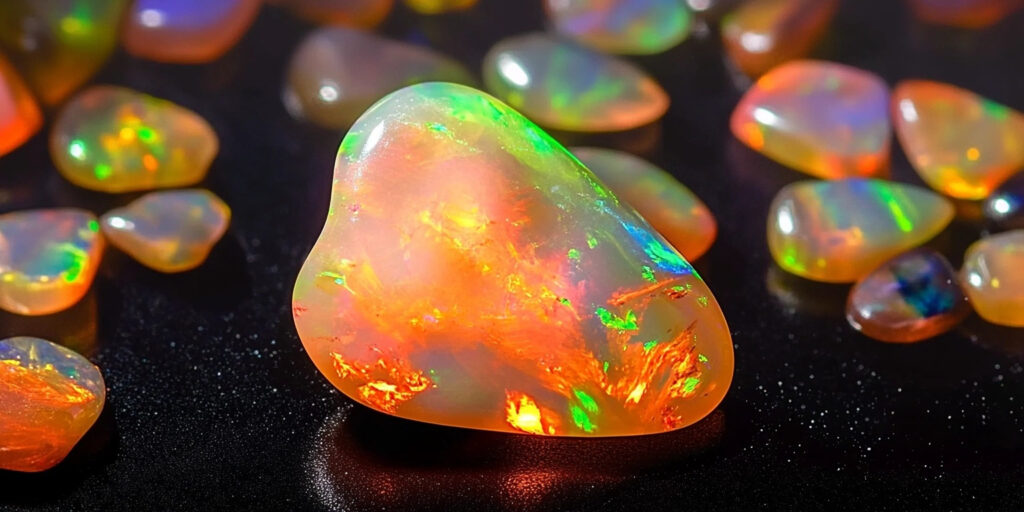
Boulder opal, found in Queensland, Australia, is a popular choice among miners due to its vibrant color play against a brown body. Its natural black backing in ironstone adds a striking contrast, similar to dark opal. Boulder opals can also display a stunning Harlequin-patterned opal effect, making them highly sought after by collectors and jewellers.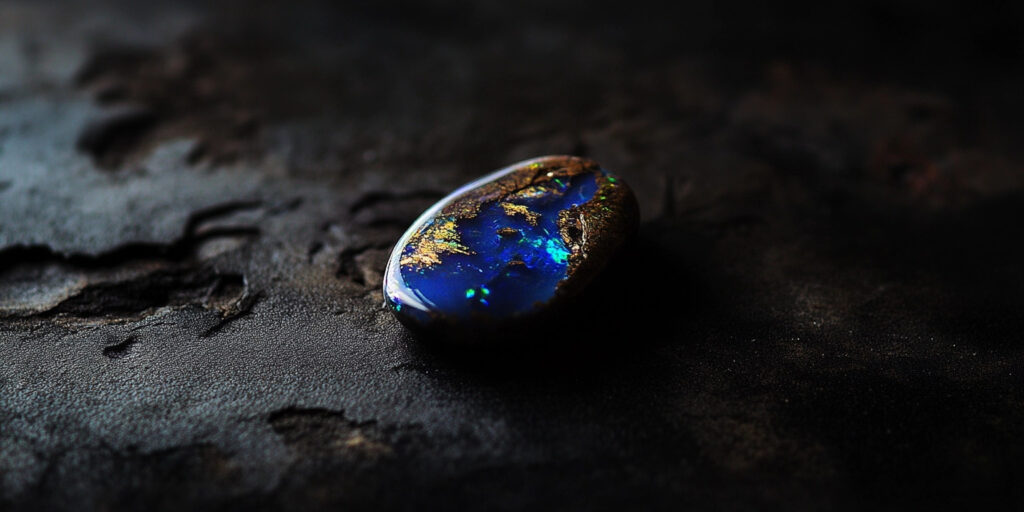
Black opal, a highly valued type of opal, is renowned for its deep, dark body tone and vibrant color play. Originating from Lightning Ridge, Australia, it is a centrepiece in both affordable and high-end jewellery collections. Its dark background allows for striking contrasts, making it a mesmerising display of colours. Synthetic opals mimic this allure but lack the fluid energy.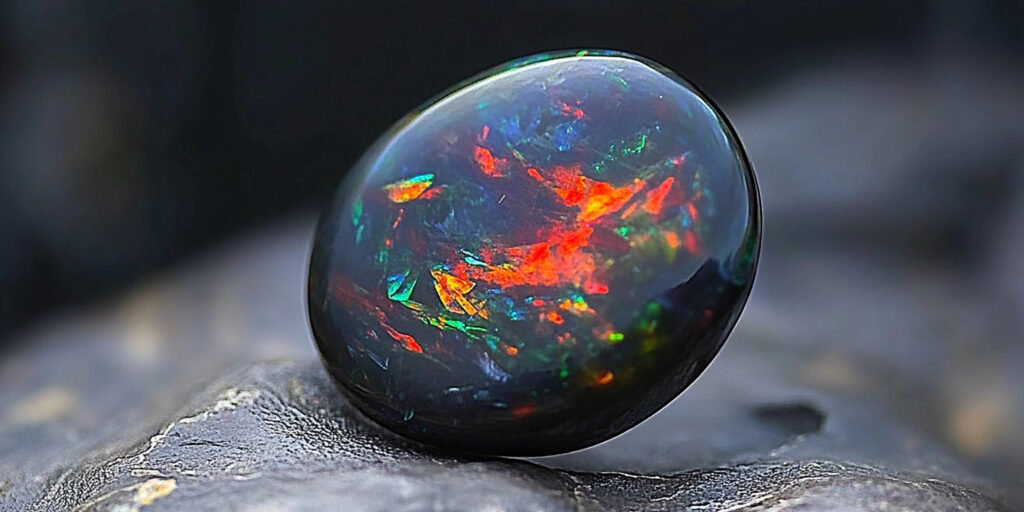
White opal, a popular type of opal sourced from Coober Pedy, Australia, is known for its light, milky body tone and subtle iridescence. Its unique allure makes it a popular choice in jewellery, often used in opal rings, earrings, and pendants. Its versatility extends to bracelets and gold opal settings, making it suitable for various occasions. Australian opal is known for its quality and beauty, making it a sought-after component in fine jewellery.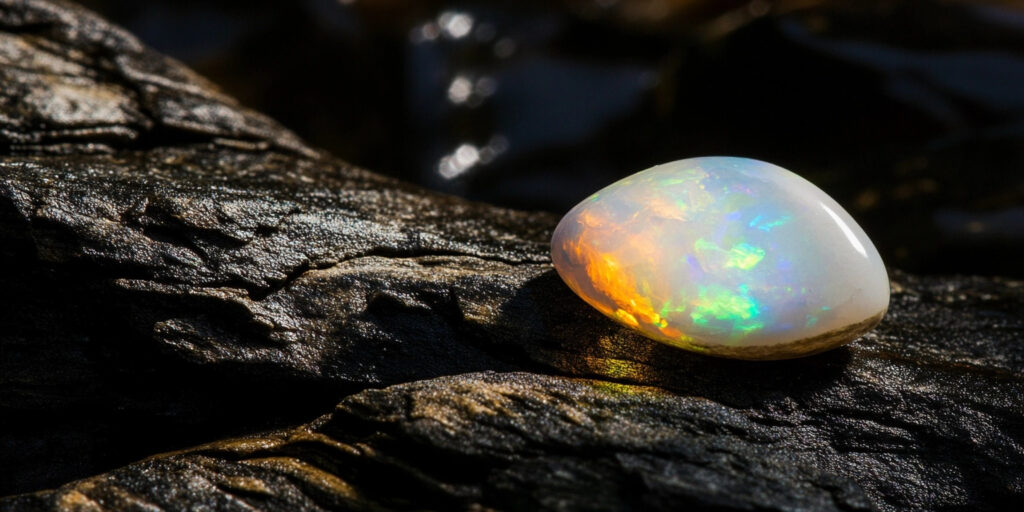
Crystal opal is the term for any variety of opal—whether black, white, or semi-black—that possesses a body that is transparent, translucent, or semi-translucent. Examples include Ethiopian Welo opal, found in diatomite deposits, and Hyalite, with its glass-like clarity.
Matrix opal is a unique type of opal where the precious material is interwoven with the host rock, creating a natural mosaic. It can be found in andesite or black trachyte rock, showcasing vibrant colours like Peruvian, ridge, and green opal. Another form is boulder opal, found in ironstone boulders, displaying colour against the earthy hues of the host rock. Varieties like moss opal also showcase the opal’s diverse beauty in various geological settings.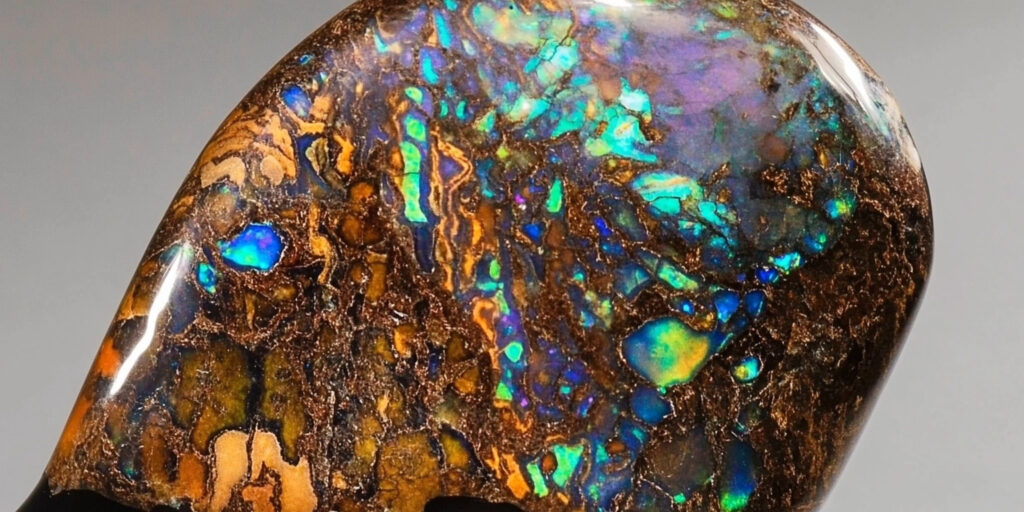
Synthetic opal is a man-made gemstone that mimics the appearance and properties of natural opal. It is used in jewellery pieces like rings and bracelets, and is often adorned with star opals and materials like cristobalite. Synthetic opals are a single, cohesive piece, providing an affordable alternative to natural opals while maintaining their enchanting characteristics.
Doublet opal is a composite gemstone with a thin layer of natural opal on a backing material, enhancing its appearance and durability. Its vibrant colours, often featuring purple gemstones, are known for their depth and shimmer. Doublets are popular in the United States and are considered symbols of good fortune. Similar to agate and wood opal, doublets offer an affordable option for those appreciating opal’s beauty. Some collectors also value lussatite for its unique qualities.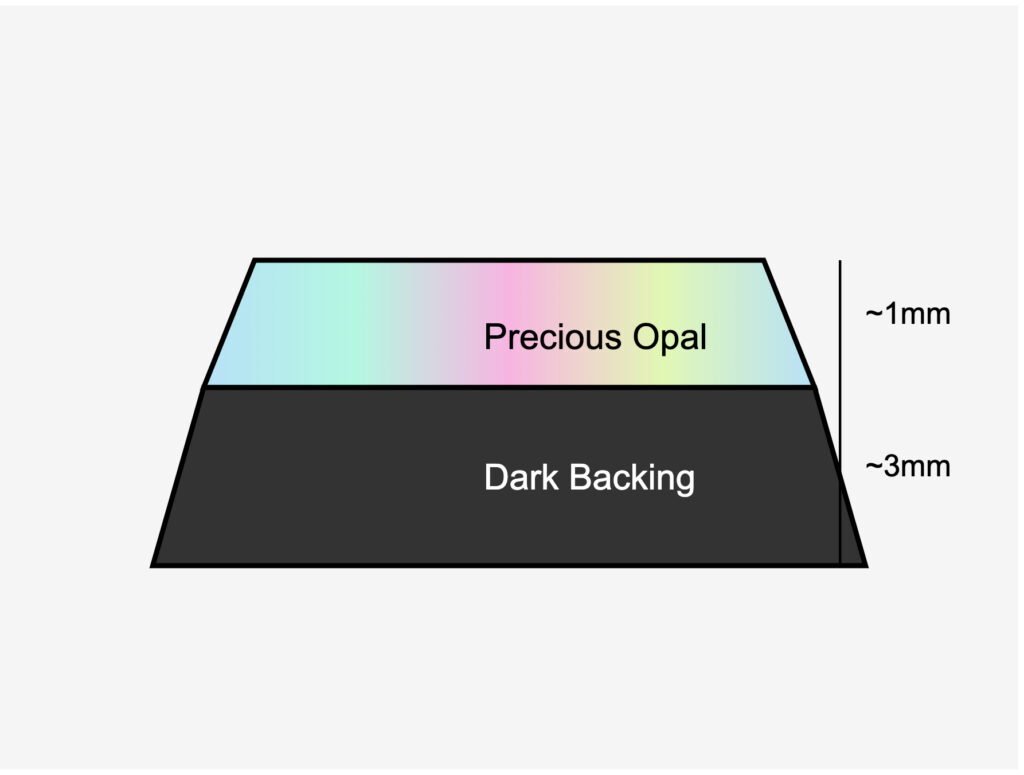
Triplet opal is a layered gemstone with a thin natural opal slice sandwiched between a dark backing and a clear protective top layer, enhancing its color and durability. Its unique composition allows its iridescent play-of-color to shine vividly, resembling the full moon’s glow. Named for its three-part structure, triplet opal offers an affordable option without compromising on visual appeal. Gemologist Sarah Regan often highlights triplet opals for their practicality and beauty, making them an attractive choice for jewellery enthusiasts.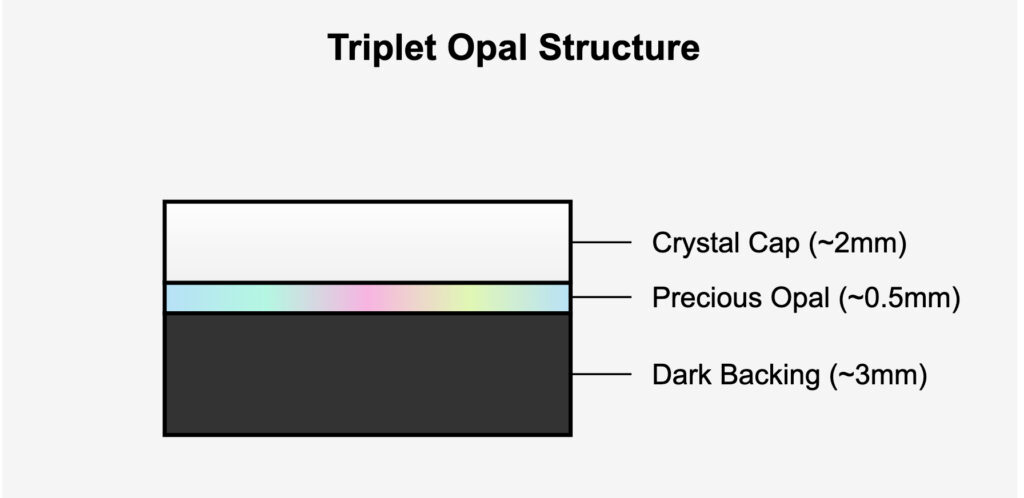
Opal and diamond differ in composition, origin, and use in the jewellery industry. Opal forms as a hydrated silica mineraloid, often found in regions like South Australia or within volcanic rock and andesite rock. Its larger spheres, millimeters in size, create a unique display of color, with flecks of color swimming across its surface. Types like Blue Opal, Light Opal, Solid Opal, Mexican fire opal, and Peruvian opal showcase varying hues and translucent opals. Treated forms, such as opal triplets and opal doublets, offer affordable jewellery options. Unique varieties include potch opal, petrified wood, and opalized wood, while famous opals highlight its allure as a modern gemstone.Diamonds, in contrast, are crystalline carbon, prized for their hardness and refractive brilliance, making them ideal for long-lasting, expensive jewellery. Unlike opals, diamonds lack the vibrant strong colours of opals and instead reflect white light with unmatched clarity. While opals are admired for their individuality and artistic appeal, diamonds dominate traditional luxury markets, with each catering to distinct preferences.
Opalescence, a phenomenon caused by light diffraction within silica spheres, creates shifting hues and patterns, offering a dynamic visual experience. Each opal is distinct, with colours varying widely and requiring careful handling. Opals are softer and more delicate than diamonds, resulting from their formation process involving water and silica. Their vibrant colour play and delicate nature make opals intriguing among gemstones.
Australia is the world’s leading source of opals due to its unique geological conditions. Ancient inland seas in regions like South Australia left silica-rich sedimentary rocks, ideal for opal formation. The arid climate facilitated silica deposition as water evaporated, preserving opals over millions of years. Major opal fields, including Coober Pedy, Lightning Ridge, and Andamooka, produce varieties like Black Opal, White Opal, and Boulder Opal. The Great Artesian Basin’s silica-rich groundwater and stable geology further contribute to Australia’s dominance in opal production.
Real opals can be identified by examining their physical and optical properties, as well as using specialised testing methods:
Andamooka opals, originating from South Australia’s Andamooka fields, are known for their unique matrix patterns and vibrant color play. They are renowned for their blue-green hues due to their photonic crystal structure. Queen Elizabeth II gifted the Andamooka Opal, while the Red Emperor is another expensive and fiery opal. These opals are often shaped into opal doublets or triplets for enhanced visual appeal and durability. Collectors and connoisseurs appreciate their unique characteristics and luxurious status in the gem world.
Coober Pedy opals, sourced from South Australia’s mining town, are known for their milky white base and vivid colour play. They are highly valued and often featured in jewellery. The town is known for producing the Flame Queen and Black Prince, with diverse opal fields including the Tree Claim and Angledool Diggings. Blue opals, with their unique hues, are sought after by collectors worldwide, enhancing the town’s gemstone market status.
Mintabie opals, sourced from South Australia’s closed opal fields, are known for their vibrant black and grey hues and blue colours, making them popular for opal pendants and bracelets. Australia’s reputation is largely due to their allure, as opals are the national gemstone. Located near Coober Pedy, Mintabie was once a thriving site. American servicemen and renowned jeweller Percy Marks popularised these opals internationally, increasing their appeal to collectors and enthusiasts.
Ethiopian opals, also known as African opals, are renowned for their vivid play-of-color and striking transparency. Originating from the Wollo region, these stones are primarily anhydrous silica, resulting in a remarkable, amorphous opal that captures light beautifully. They are often found in larger carat stones, appealing to collectors and jewellers. In modern philanthropy, Ethiopian opals are sometimes used to support local communities, adding further value to their value.
Harlequin pattern opal, a rare and valuable gemstone, features a checkerboard-like arrangement of vibrant hues, including electric blue. Unlike artificial opals, Harlequin opals are naturally formed in diatomite-rich environments, where cristobalite plays a role. Mining and handling can be dangerous, and the rarity of this double-sided gem makes it a treasure among collectors. The opal’s lussatite and girasol characteristics further enhance its appeal, much like the allure of standard oil art.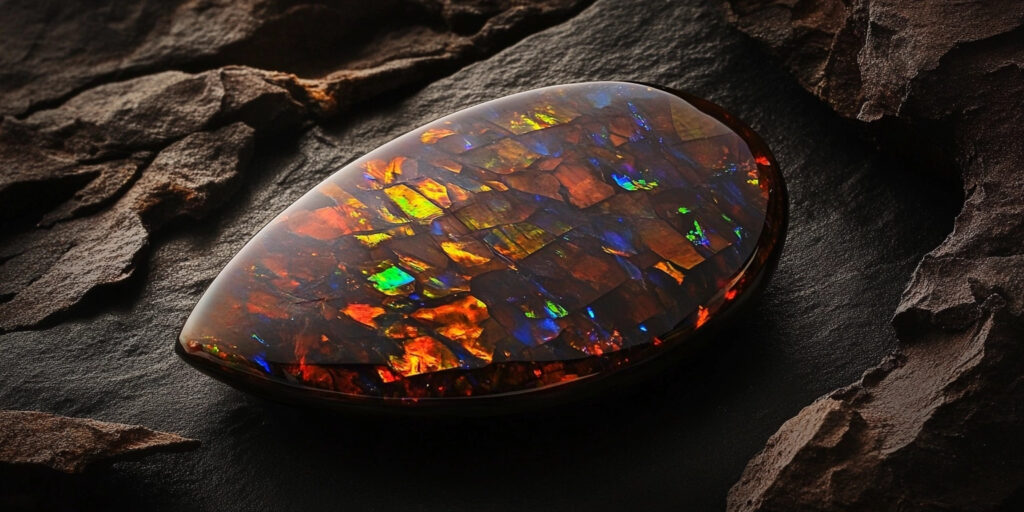
Pinfire pattern opals are a unique type of gemstone with a constellation of small flashes of color scattered across their surface. These opals are highly valued for their intricate play of colours, often featuring red streaks and blue veins. The vibrant red-green hues are reminiscent of the aurora and southern lights. Some opals may even contain imperfections, adding character.
Flashfire pattern opals are renowned for their vibrant flashes of color that appear and disappear as the stone is moved. These opals, often featuring a striking blue border, resemble the flutter of a red admiral butterfly, attracting collectors in their search for unique gemstones. The Lunatic Hill Syndicate discovered several renowned flashfire opals, drawing parallels to opal legends like Walter Bradley and Tom Urwin.
Opals are extracted from sedimentary rock formations using traditional mining techniques like picks and shovels. Modern methods use advanced machinery like bulldozers and hydraulic excavators for efficiency and safety. Authentic opals display a unique colour play due to their internal structure, which diffracts light. Professionals use magnification and light sources to identify these optical properties, while imitations may appear uniform.
Opals are processed through cutting, shaping, and polishing to enhance their natural beauty and reveal unique colour patterns. Skilled artisans slice the opal to remove imperfections and achieve the desired shape. The cut pieces are then polished to reveal the vibrant play-of-colour, a hallmark of genuine opals. Authentic opals have a smooth texture and consistent weight, while synthetic or imitation opals may lack the depth and dynamic colour patterns of natural opals.
Opal is widely used in jewellery for its vibrant colours and unique patterns, appearing in rings, necklaces, and earrings. It is also valued by collectors and museums for its rarity and beauty, with famous opals being highly sought after. In spiritual practices, opals are believed to enhance positive energy and creativity. They are also studied scientifically to understand silica formation and geological history and are used decoratively in forms like opalized wood.
Distinguishing fake opal from genuine opal involves examining colour play, structure, and origin. Real opals have a natural, dynamic colour play and irregular structure, often sourced from reputable regions like Australia, while imitations use glass or plastic, lacking vibrant colours.
To care for opals, protect them from heat, dryness, and impacts, as their water content and softness make them prone to cracking or scratching. Clean them gently with a damp cloth, avoiding harsh chemicals or ultrasonic cleaners. Store opals separately from harder gemstones in a padded box or pouch to prevent damage. Regularly check the settings of opal jewellery to ensure the stones remain secure. Proper handling and storage help preserve their beauty and longevity.
Mohs hardness of 5.5-6.5, specific gravity of 1.98-2.25, and refractive index between 1.37-1.47.





